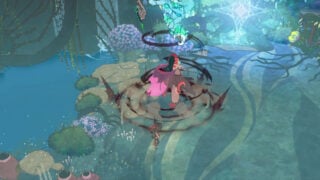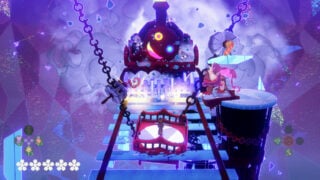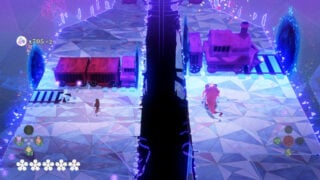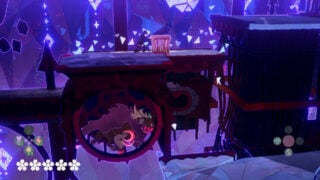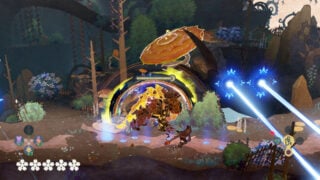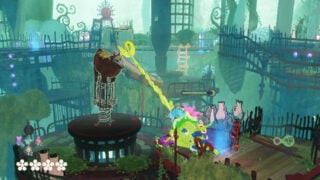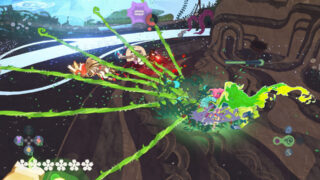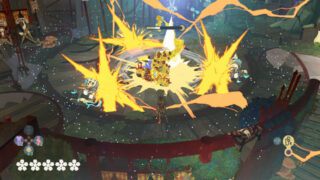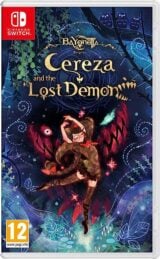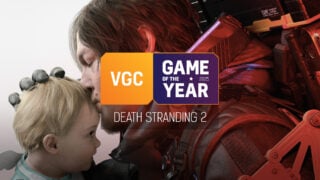Bayonetta Origins offers a taste of what Platinum does best
Once upon a time, Platinum made a very unusual action adventure…

More thorough Bayonetta 3 players were surprised to find a whole other game hidden inside last year’s Switch release – or least the hint of one.
Collecting three keys unlocked a playable picture book in which Cereza, aka young Bayonetta, nervously trotted through watercolour woods, only to be ambushed by fairies and a tantalising ‘to be continued’. Platinum now makes good on that promise with a beguiling standalone prequel.
Origins joins Bayonetta at a different point in life. She’s barely out of baby shoes, let alone ready to strap handguns to her ankles, and the action shifts accordingly. Just as Mario’s toddler years demanded the new play style of Yoshi’s Island, we meet our would-be witch in similar need of an animal protector. Enter Cheshire the cat: a stuffed toy who, thanks to a flubbed summoning ritual, can transform into a hulking bodyguard.

Bayonetta 3 veterans will recognise the patchwork puss as a support summon, only there he was AI-controlled while Viola battered enemies. Bayonetta Origins puts us in control by lifting its defining trick from ‘solo co-op’ gem Brothers: A Tale Of Two Sons. That game mapped two heroes to two analogue sticks for simultaneous movement, and likewise here you steer Cereza out of danger on the left stick as Cheshire deals out clawed death on the right.
It evolves into something a little more involved than Brothers, but shares a similar learning curve. At the outset there are paths only Cheshire can reach, and patches of demon-repelling rosemary that force the pair to split across high and low ground. Tame by Platinum’s action standards, perhaps, but it lets the odd control scheme bed in; learning to pilot two characters in opposite directions is like rubbing your tummy and patting your head.
Heading deeper into the fairy domain teases out more imaginative ‘you scratch my back, I’ll scratch yours’ collaboration. Only Cereza can grow plant platforms, for example, while Cheshire’s claws are needed to trim back thick roots. Soon there are Venus flytraps that Cereza binds in brambles before Cheshire finishes them off – a one-two punch that eventually becomes key to the game’s combat (more on that in a moment).
Given how some games struggle to nail tactile controls for one character, let alone two, it’s striking how Platinum work with the Joy-Cons. All key moves are on sticks and triggers, leaving face buttons for potions and altering Cheshire’s elemental state. A stick-tilting rhythm game used to activate Cereza’s spells is such a clever way of squeezing extra ideas into very little real estate. (And hints at the gyrating death she’ll dish out later in life.)
Complexity bleeds in through Cheshire’s elemental additions, each one adding a move into his repertoire that opens up new puzzles or combat tricks. Wood Cheshire’s vine grapple, for instance, lets him pull down rusting funfair apparatus or tug trains along their tracks, creating new paths for Cereza.
The way the forest is built around distinct themed areas designed to showcase a particular Cheshire power gives Origins a hint of Zelda dungeons, particularly those few that involved Link pairing up with (and exploiting) an ally. Perhaps this shouldn’t come as a surprise if you recall Platinum’s founders’ work on Okami – that’s an awful lot of action adventure knowhow that maybe hasn’t had a chance to shine until now.
Of course, when combat does erupt it does so with all the snap and snarl you’d expect from Bayonetta, albeit recalibrated around a tag-team. Cereza’s role (at least at this early on in her skill tree) is to avoid trouble and tangle enemies up in brambles to make Cheshire’s job easier. That job is to absolutely monster fairies with powerful combos, or charge up an angry bite that kills staggered imps in one snap of the jaws. Chomping a final attacker, paired with a burst of victorious slow-mo, is something to relish.
In battle Cheshire’s elemental oomph comes into its own, too. The grapple is now yanking aerial enemies into the dirt or tugging shields away from fairy knights, letting you lob them straight back, while the ground pound unearths subterranean creatures or shatters rock barriers. And it’s not as if regular Cheshire is ignored – his power is a parrying twirl, crucial for unbalancing bigger bosses and returning projectiles to sender.
It’s a combat system distinct from Bayonetta’s, but not without Platinum precedence. Mixing up Cheshire’s forms might trigger something in Wonderful 101 fans; instead of squeezing complex combos from a single hero you’re switching between broader classes each bringing a distinct power to the party. The vine is basically the whip; the ground pound mimics the hammer. Like W101, it’s a less surgical game, but just as satisfying in its thumpy bravado.

Coming so soon after Bayonetta 3 – a conceptually challenging brawler that drowns you in constant monster unlocks and oblique systems – Origins is bound to feel basic by comparison.
You might even wonder why Platinum is taking a series beloved by action fans and attempting to mould something friendlier, both mechanically and visually. You wouldn’t call Origins a family game – it’s chock full of demons and folkloric oddities – but there’s a tweeness and simplicity that feels like a bid to put Bayonetta in front of a different audience.
Whether or not it’ll succeed in opening the series up is hard to call from a handful of opening levels. Will kids be drawn in by the storybook charm and come out the other end as pure Platinum acolytes? Hard to say. But anyone picking up Origins *is* going to get a taste of what Platinum does best – good characters clobbering bad characters – and probably find it more welcoming than their other games.
The question that remains is where this journey ends? Whether Origins will escalate to the levels of combat and puzzle complexity to challenge veteran fans, or settle for bringing newcomers through a colourful and elegant action adventure that more people can enjoy. In truth, there’s nothing wrong with either approach, and we are more than enthralled enough to see what answer they land on.





